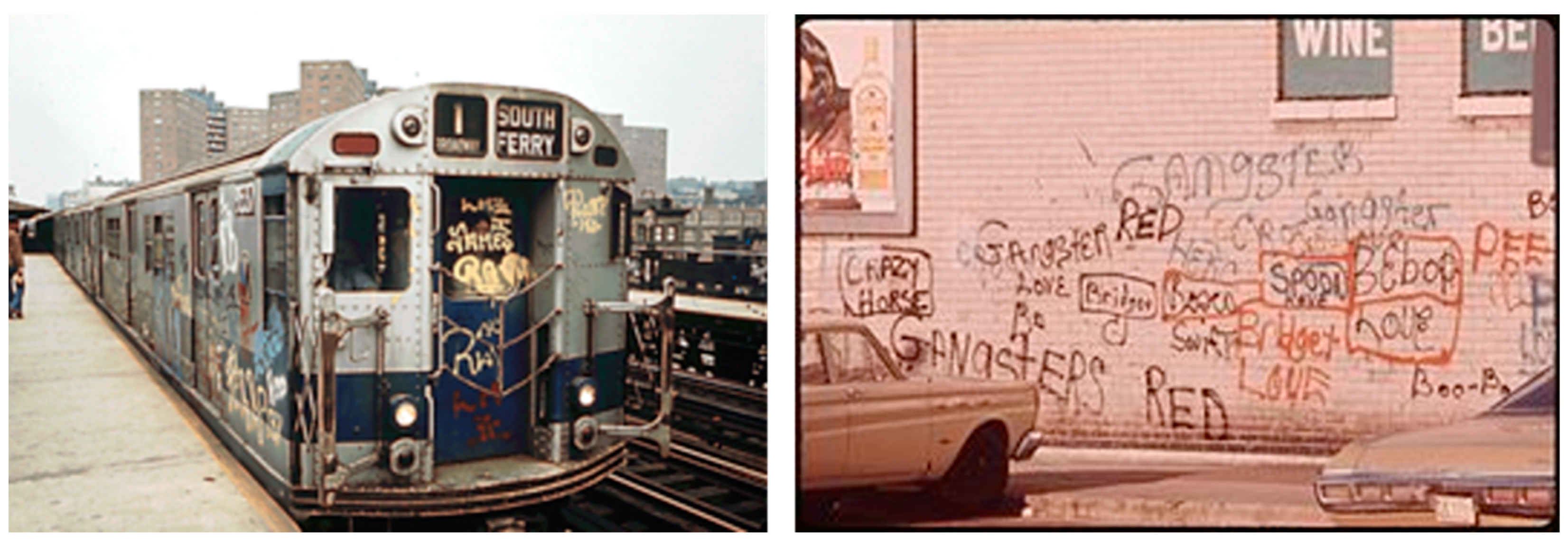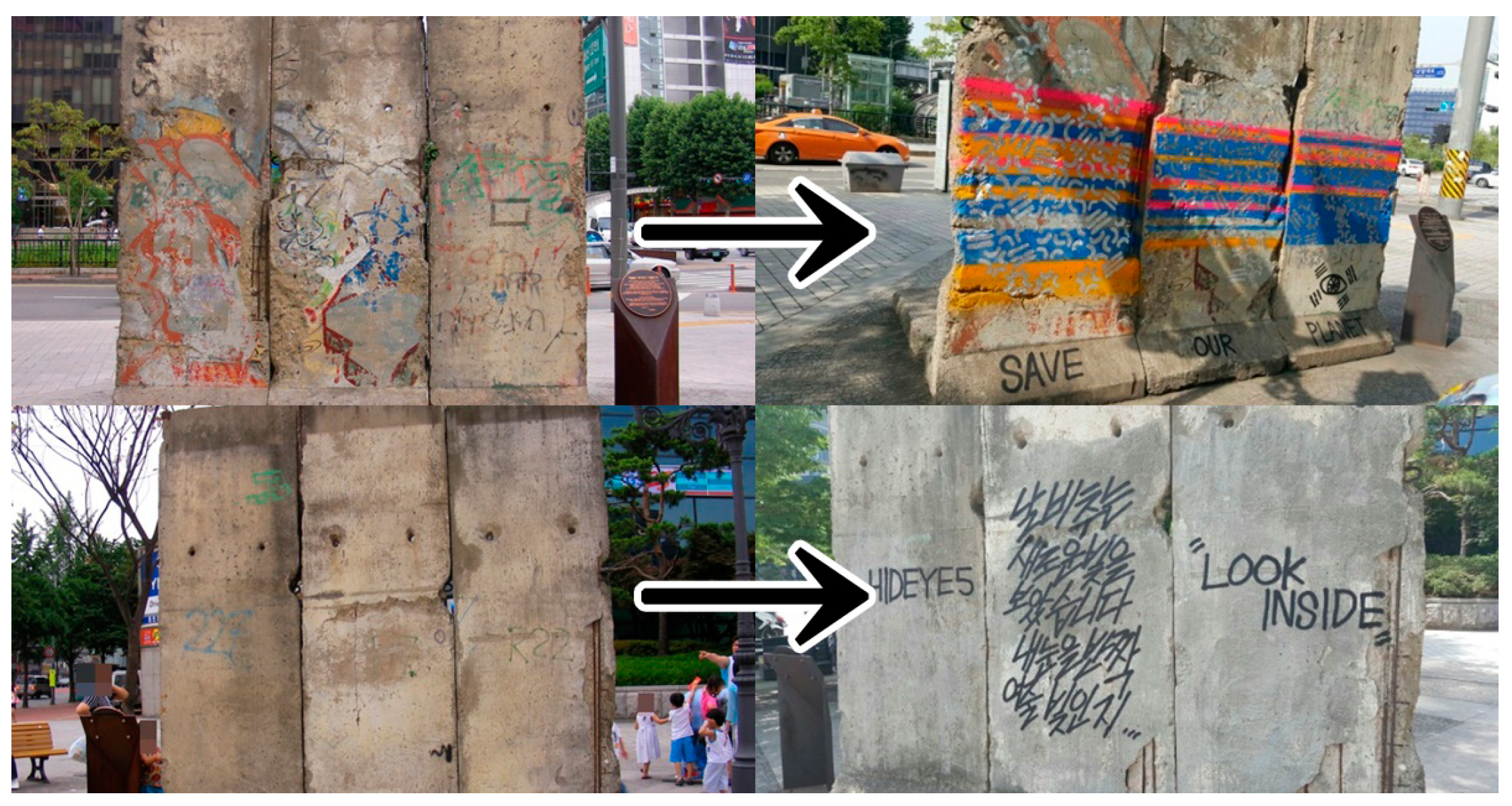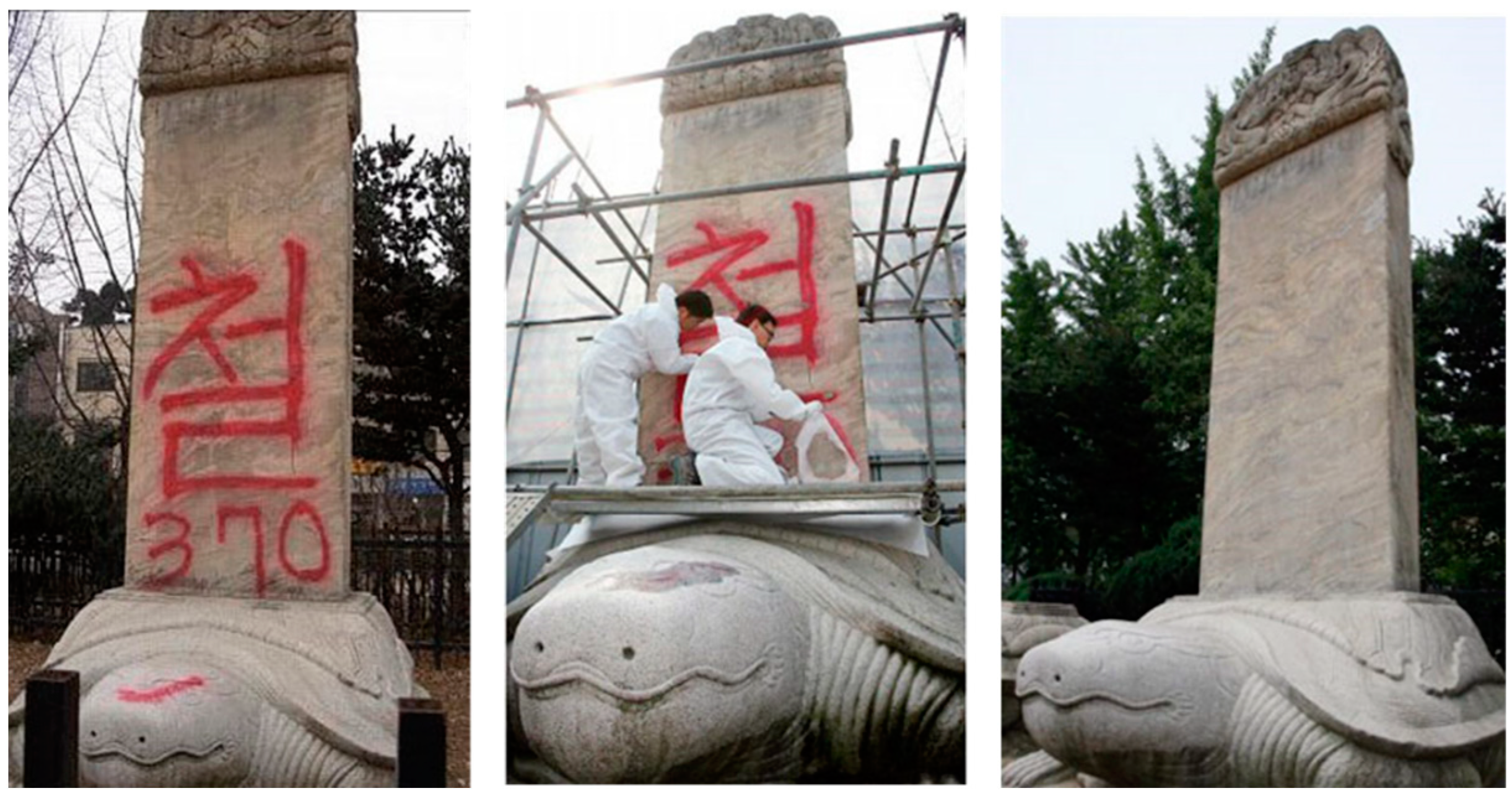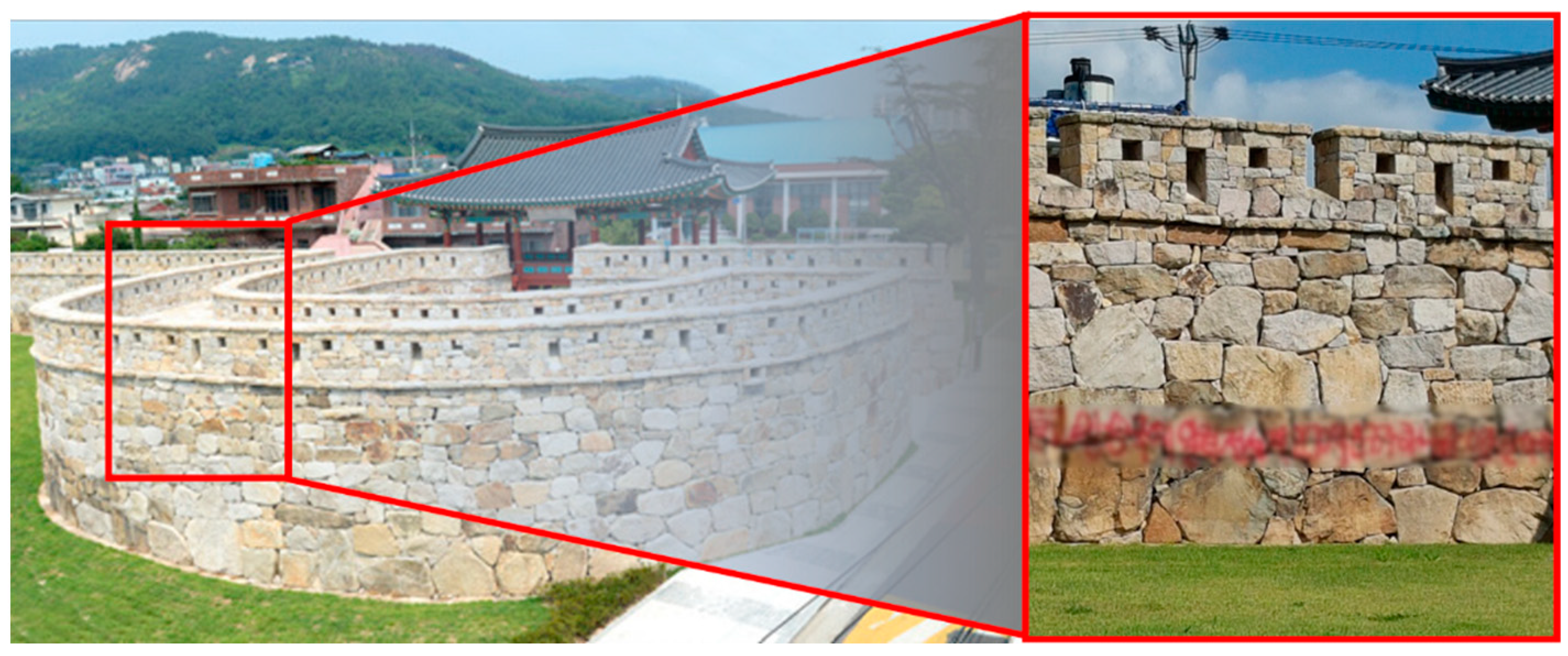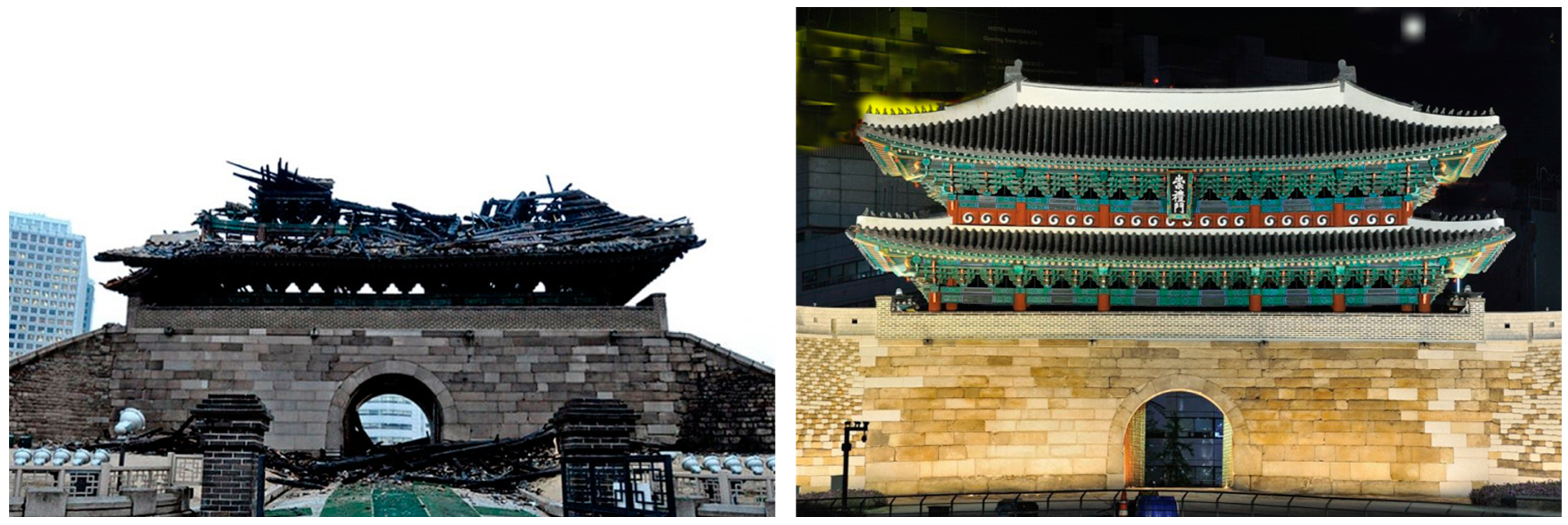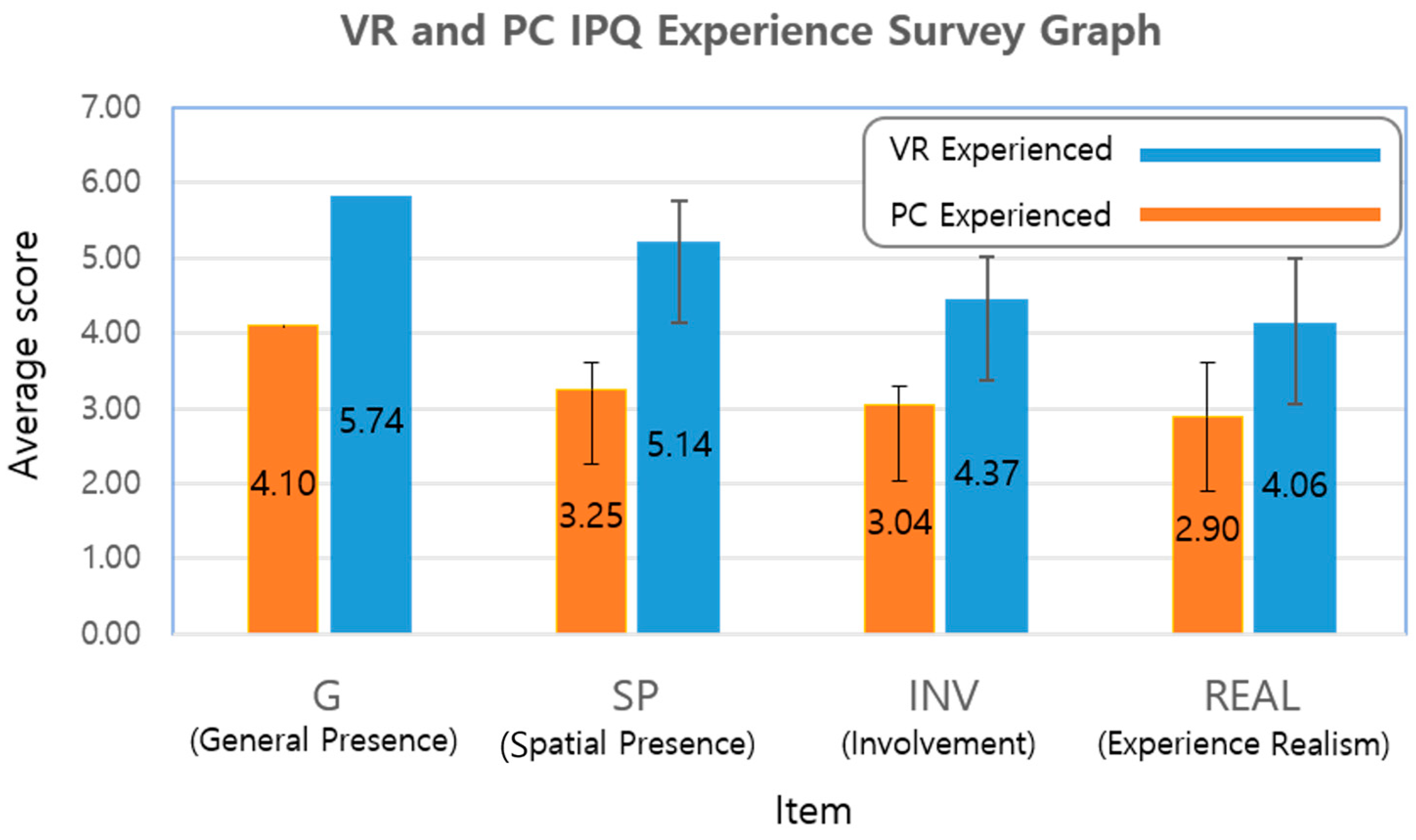1. Introduction
In the dynamic intersection of urban development and cultural expression, graffiti emerges as a vivid yet contentious art form. This study delves into its dualistic essence, recognizing graffiti as both a medium of creative expression and a focal point of societal debate [
1]. Emblematic of urban artistry and often perceived as an act of rebellion, graffiti’s presence in public spaces ignites discussions around legality, urban cleanliness, and respect for public property [
2]. Such a paradox presents a singular challenge: how to maintain the cultural importance of graffiti while navigating its legal and societal intricacies [
3].
Advancements in virtual reality (VR) technology, particularly in the developing realm of the metaverse, present a pioneering solution [
4]. The metaverse, a digital universe crafted with advanced computer graphics and VR, operates in tandem with the physical world, facilitating immersive and realistic interactions within a controlled, virtual setting [
5]. This digital space mirrors real-life dynamics but provides a unique platform that transcends the constraints of the physical world [
6].
This study proposes the integration of graffiti art into the metaverse, envisioning it as a groundbreaking approach in tackling the inherent challenges of graffiti in physical environments [
7]. Transitioning graffiti into virtual realms allows artists to express their creativity uninhibitedly, without transgressing the boundaries of public or private properties [
8]. This innovative shift promises to preserve the integrity of urban spaces and adhere to legal standards of artistic expression [
9]. Moreover, the virtual replication of cityscapes in the metaverse opens up a new canvas for graffiti artists, offering them a space to exhibit their work and connect with a wider audience [
10].
Through an exploration of the amalgamation of urban art and virtual technology, this study seeks to provide an exhaustive analysis of the feasibility of a graffiti system within a metaverse platform. By scrutinizing the amalgamation of graffiti within the metaverse, this study aims to confront the social ramifications of graffiti and encourage artistic innovation in a technologically advancing landscape.
2. Background
2.1. Development Process of Graffiti
Modern graffiti, as it is generally understood today, refers to the artwork created using spray paint on public facilities or building walls. This art form has evolved to encompass a wide range of styles, from basic and straightforward expressions to more elaborate and intricate paintings. One of the key features of modern graffiti is the use of typography, which is often complex and artistically integrated into the designs, as depicted in
Figure 1.
The development of graffiti as a prominent form of urban art dates back to the 1960s and 1970s, particularly in bustling urban centers like New York City. Initially, graffiti was primarily composed of tags, which are stylized signatures of the artists. These tags were a way for individuals to mark a territory or express their identity. Over time, these tags evolved into more complex and artistic forms, including large murals which covered entire walls or sides of buildings [
11,
12].
The rise of graffiti coincided with a period of significant socio-political change. For many artists, graffiti became a medium for social and political expression [
13]. It was a way for voices that were often marginalized or overlooked to be heard in a very public and visual manner. The walls of cities became canvases for commentary on societal issues, personal messages, and artistic expression [
14].
Graffiti’s evolution from simple tags to elaborate murals reflects a broader conceptual and expressive development in the art world. Since the 1970s, discussions about graffiti have become increasingly prominent in art circles, often focusing on its role as a form of avant-garde art [
15]. These discussions revolve around topics such as the legitimacy of graffiti as an art form, its impact on urban spaces, and its expression of social and political themes [
16]
Expanding this perspective, academic studies in art history, sociology, and urban studies have explored graffiti’s role as a voice for marginalized groups and a tool for identity construction in urban environments [
17].
In art history, graffiti’s journey from streets to galleries is epitomized by artists like Jean-Michel Basquiat, who began under the tag “SAMO” in New York City. His work, merging street art with various artistic styles, exemplifies the transition from graffiti to recognized fine art, challenging traditional art norms [
18]. This transformation, pivotal in post-modern art, highlights graffiti’s role in introducing new aesthetics and perspectives, often studied to understand the evolution of contemporary art [
19].
Sociologically, graffiti serves as a lens for viewing subcultures and identity formation, particularly among youth. Graffiti culture in the 1970s’ Bronx, closely tied to hip-hop, is a classic example of how street art helped shape community identity. Moreover, graffiti is analyzed as a medium of social and political commentary, offering insights into public sentiments during times of unrest. The graffiti in Athens during Greece’s economic crisis are a poignant example, illustrating how public expression in urban spaces can reflect and influence societal narratives.
In urban studies, graffiti’s impact extends to urban regeneration and policy-making. The Wynwood Walls in Miami demonstrate how graffiti can transform neglected areas into vibrant cultural hubs, prompting discussions on urban renewal. Cities like Melbourne, renowned for their graffiti-laden laneways, provide case studies for urban planners and policymakers, balancing the need to control vandalism while fostering urban art and culture.
2.2. The Problems of Graffiti
There was an incident in which a young Korean artist damaged part of the Berlin Wall, a piece of which he donated to the Seoul Metropolitan Government in hopes of peace on the Korean Peninsula. This case, shown in
Figure 2, was criticized in Korea at the time and became an important example of how graffiti undermines the importance of cultural properties and becomes a problem [
20].
Graffiti, often involving the use of spray paint, markers, or other stubborn-to-remove materials, poses a distinctive social problem by causing damage to both public and private property. This damage, as illustrated in
Figure 3, can extend to buildings, bridges, and various infrastructures, necessitating costly repairs [
21]. Furthermore, graffiti can detract from the aesthetic appeal of local traditional cultural heritage sites, making them appear old and unattractive. This is further emphasized in
Figure 4, where graffiti’s impact on the appearance of a cultural heritage site is evident [
22].
These instances underscore graffiti’s destructive and financially burdensome impact on urban communities. Graffiti can lead to a reduction in property value, create safety hazards, and negatively affect community perceptions, which, in turn, can interfere with business operations and tourism [
23]. Traditional punitive measures, such as fines and prosecutions, have often been inadequate in addressing these issues, as they tend to overlook the underlying causes of graffiti.
In summary, while graffiti can be an expressive art form, its unregulated application can lead to significant challenges for urban environments, affecting both the aesthetics and economic well-being of communities.
2.3. Benefits of the VR Metaverse
The metaverse, a concept increasingly gaining traction in both technological and academic circles, represents a virtual space where digital and real worlds converge. Central to this convergence are technologies like virtual reality (VR), augmented reality (AR), and 3D computing. These technologies collectively forge a platform that offers an unprecedented level of immersion and interaction, key elements which define the metaverse experience [
24,
25,
26].
In the context of VR within the metaverse, “Reality” and “Spatial Presence” are two fundamental aspects that academics focus on to understand and articulate its advantages. VR technology, through its use of computer-generated 3D environments, facilitates experiences that are remarkably similar to real life [
27].
‘Spatial Presence’, a crucial component in VR, refers to the sensation of physically being in a virtual environment. This sensation is more profound in VR compared to traditional 2D interfaces [
28]. In VR, users wear specialized headsets that track head movements and adjust the visual displays accordingly, creating a highly immersive experience which mimics real-life interactions [
29]. This feature of VR in the metaverse allows for a sense of presence that goes beyond what is possible in conventional computer interactions. For instance, while playing a game on a PC involves using a mouse and keyboard to interact with a 3D environment on a 2D screen, VR employs motion controllers and head-tracking to facilitate a more natural and intuitive interaction with the virtual world.
In VR, the objects and elements of a game or virtual environment can be manipulated through physical hand gestures, adding a layer of realism and tangibility to the experience. This ability to interact with the virtual environment in a manner that closely mimics real-world interactions significantly enhances the sense of spatial presence. Users are not just passive observers but active participants in the virtual world, experiencing it in a 360-degree environment [
30].
This heightened sense of presence and realism in the VR-powered metaverse has far-reaching implications. It opens up new possibilities for experiential learning, immersive entertainment, and realistic simulations for training purposes across various fields. In the metaverse, these experiences are not confined by the physical limitations of the real world, offering a new realm of exploration and interaction which is both innovative and transformative [
31].
2.4. Roblox
Roblox is a powerful metaverse platform that has had a significant impact on creativity and socialization. This platform created a thriving community of game developers and designers and provided students with an attractive learning experience. This allows users to create their own games and socialize and interact with other players. Roblox creates a virtual world where players can interact with other players around the world.
In Roblox, graffiti can be experienced without damaging real buildings or walls. Drawing graffiti in a virtual environment is a way to express art freely without legal problems. In addition, when graffiti is drawn on a real building or wall, it is very difficult to modify or erase it. However, if one draws graffiti on the Roblox platform, one can easily modify or remove it completely. This is advantageous for experiments and learning and reduces the burden of unwanted results.
This offers creative possibilities that are difficult to experience in real graffiti. Accordingly, experiencing graffiti in Roblox solves legal and environmental problems, physical risks, and resource constraints, thus enabling creative and diverse experiences.
There have been applications for graffiti or drawings in virtual environments, but few users participate in these together.
Table 1, below, is a table that summarizes graffiti contents using VR. All of the specified applications are tools that enable creative activities in a VR environment. Medium and Gravity Sketch are 3D tools that can be modeled in the air. Kingspray Graffiti VR, Vermillion, and Gravity Sketch have a collaborative function, but only a small number of people, four or less, can participate. The proposed system in Roblox allows up to 50 users to draw graffiti in the same virtual space. Through this, murals can be produced in collaboration with various users.
3. Proposal of Graffiti System Development
3.1. VR System Development
In Roblox Studio, an interaction between local and server scripts is required for a user to deliver scripts to all clients through the server. The flowchart used to address this situation is presented in
Table 2. In this strategy, objects created by a client are not transmitted to the server. Instead, the server directly creates and manages the objects.
This methodology promotes a unified control mechanism, minimizing potential unauthorized changes or vulnerabilities from separate clients. By designating the server as the main entity for generating and overseeing objects, the game’s environment remains stable and secure. Additionally, this strategy boosts efficiency, as the server is adept at processing and disseminating essential data to every active client without awaiting distinct client responses. This consolidated framework eases the process of identifying and resolving issues, allowing developers to concentrate on the server’s operations without the distraction of diverse client-side behaviors.
The term metaverse refers to a virtual space in the digital world, where users can engage in various activities through their avatars. Avatars are your digital representatives, responsible for your actions and interactions within the metaverse. In this metaverse space, avatars can utilize various tools. You can use brushes of various sizes, especially when you are performing activities related to drawing. Large brushes are useful for painting large areas of a background color or drawing rough sketches, and small brushes are used for drawing or adding details. Using these different sizes of brushes, you can increase the expressiveness of your paintings. In addition, a palette menu allows users to select and use the color they want by offering a palette of different colors that the user can choose from and apply to their picture. If you make a mistake or want to fix something while drawing, you can easily fix it using the mop tool. The mop tool is a tool used to erase or modify parts of a picture, allowing the user to select and erase only the parts that he or she wants. Using this mop tool, you can freely modify and create high-quality works, even in the middle of painting.
Roblox is generally accessed using a PC or mobile device. To improve user interaction and painting experience with the tools, we developed a method for improving immersion through a VR input device.
Figure 5 shows the operation method of a Meta Quest 2 controller, which is a VR device, in Roblox.
The left controller’s button 1 is used for player movement, allowing the user to navigate through the virtual space. Button 2 is a toggle for the user interface (UI), providing access to the system’s menu and various features. Button 3 is designated as a tool-select button on the left controller, which can be used to switch between different tools.
On the right controller, button 4 functions similarly to a mouse left-click and may be used for selecting items or painting on walls within the VR environment. Button 5 also serves as a tool-select button, mirroring the function of button 3. Button 6 is utilized to exit games or applications, a standard feature for navigating back to the main menu or closing a program. Button 7 corresponds to the jump action, a common control in many VR games, enabling the player to leap within the virtual environment. Finally, button 8 allows for switching between VR mode and other modes, enabling both stationary or seated experiences and fully immersive environments.
Figure 6 shows how the Roblox software and VR hardware are connected. The VR controller input can be processed using programming. The VR controller can be programmed to recognize movements and button clicks using a Lua script. Tools can be developed to create graffiti in VR. These tools should allow users to draw using a VR controller by leveraging its movement and location data. In order to start accessing Roblox using VR, install and run the Oculus PC app on your computer. Additionally, create a user interface (UI) within the VR environment that enables users to choose colors. Instead of traditional UI elements, VR controllers can be used to select colors from color palettes. If MetaQuest 2 is used, the meta-link functionality can be enabled. Turn on your Meta Quest 2 device, navigate to the “Settings” menu, select “Device”, and activate “Meta-Link”. Finally, install and run “Roblox Player” on your PC. Ensure that the “Meta-Link” is enabled on your MetaQuest 2 device before launching “Roblox Player”.
3.2. Metaverse Cultural Heritage Selection
To explain the significance of graffiti activities within the metaverse, this study aimed to address a virtual environment that includes Sungnyemun, in Korea. Sungnyemun Gate is a historic building located in Jung-gu, Seoul, Republic of Korea, and is an important cultural point connecting Gyeongbokgung Palace, a Joseon dynasty palace, and the center of Seoul. This gate symbolizes the national importance and authority of the Joseon dynasty, as well as the history and cultural heritage of Korea [
32].
However, as shown in
Figure 7, from the 10th to the 11th of February in 2008, Sungnyemun was burned by arson [
33]. This emphasized the importance of cultural properties and their management and remains a symbol that raised awareness of the fact that descendants should not neglect to preserve cultural heritage. Fortunately, Sungnyemun has been rebuilt, and many domestic and foreign tourists have visited it to experience the history and traditions of the Joseon dynasty and the cultural values of Korea [
34].
There are various reasons for including Sungnyemun, which has cultural heritage and historical value, in the metaverse.
First, the metaverse can make cultural heritage sites like Sungnyemun accessible to a broader audience, including those who may not have the means or ability to visit in person [
35]. This digital inclusivity ensures that more people can experience and appreciate cultural heritage, regardless of geographical or physical limitations.
Second, recreating Sungnyemun in the metaverse is an opportunity for digital preservation. This is particularly important in safeguarding this site against potential damage due to natural disasters, human conflict, or environmental degradation [
36]. Digital archiving in the metaverse can serve as a lasting record of cultural heritage sites in their current state for future generations.
Third, the metaverse offers an engaging and interactive platform for education. Younger generations, who are native to digital environments, might find learning about cultural heritage more appealing in a virtual space [
37,
38]. This approach can be especially effective in schools and educational programs, offering a dynamic way of teaching history and culture.
Fourth, the metaverse allows for innovative forms of artistic and cultural expression that can complement traditional interpretations. It can be a platform for contemporary artists and cultural practitioners to reinterpret and showcase cultural heritage in new, creative ways [
39,
40].
Beyond physical sites, the metaverse can be used to preserve and promote intangible cultural heritage, such as music, dance, rituals, and languages. This aspect of cultural heritage is often harder to preserve, and the metaverse offers a unique platform for its continuation and evolution.
Figure 8 shows a 3D Sungnyemun modeling file installed on the Roblox platform and a virtual reality world implemented with graffiti functions.
4. Experiments and Result
In a study involving 62 participants, they were evenly divided into two groups to explore different content versions on PC and VR, each group comprising 31 individuals. The entire experience lasted for 60 min and was then followed by a survey to gather feedback. All the participants were college students in their twenties who had never experienced VR content before. Both the PC and VR users were first introduced to a 20 min tutorial on the interface of graffiti functions, followed by a hands-on session. After the tutorial, they took a 10 min break and then participated in making graffiti for 30 min. For the VR group, special safety training was conducted to instruct the participants to immediately stop the experience if they felt any symptoms of dizziness or discomfort during the VR session.
We aimed to ascertain if the unique characteristics of VR, such as immersive interaction, contributed to higher scores in general presence (G), spatial presence (SP), involvement (INV), and empirical reality (REAL), as measured using the Igroup Presence Questionnaire (IPQ). Therefore, to measure the potential influence of VR on the IPQ scores, we conducted a comparative experiment with a conventional gaming environment, using a keyboard and a mouse in the PC setup.
The virtual graffiti space, while differing in the equipment used, was created under identical conditions regarding objects, scale, and lighting in both the VR and PC environments. Graffiti drawing was conducted as part of a collaborative effort in both environments. The participants were able to draw using one of three different-sized brushes—small, medium, and large. The participants were divided into three groups based on the brush size they possessed. The smaller brushes allowed for finer details but covered a smaller area, whereas the larger brushes could cover larger areas but lacked the ability to depict fine details. This necessitated participants to collaborate and consult each other to complete a drawing.
Both the VR and PC participants performed tasks in an environment where real-world conversation with other participants was not possible. The participants in each environment used Roblox’s spatial voice function for social interaction, enabling real-time communication with surrounding users through a microphone located on their virtual avatar. The closer a user is to others, the louder their voice becomes, and vice versa. This technology facilitated idea- and presentation-sharing among the graffiti groups in the metaverse space.
The participants in the VR environment could view the virtual space in 360 degrees using a VR HMD. The left VR controller was used for avatar movement, while the right VR controller allowed participants to draw on walls, simulating holding a brush. A color palette on the right UI could be used to select colors with the right controller for painting. This interaction, compared to the PC environment where movement is controlled by a keyboard and drawing and rotation by a mouse, offers more realistic movements and, hence, a more immersive graffiti experience. We proceeded with the PC and VR environment as follows for the experiment:
OS: Windows 11;
CPU: Intel(R) Core(TM) i7–10870H 2.20 GHz;
RAM: 16.0 GB;
GPU: NVIDIA GrForece RTX 3070 Laptop;
VR Device: Meta Quest 2.
Roblox Studio software version: 0.604.0.6040509
Oculus software version: 59.0.0.179.366
In this study, the IPQ developed by Schubert et al. (2001) was modified and used to reflect the characteristics of virtual reality. The modified IPQ comprised fourteen questions, as follows: one general question, five questions about local presence, four questions about immersion in the virtual world, and four questions about practicality. The reliability of the IPQ test paper was reported as 0.87.
Table 3 shows the complete questionnaire form for the IPQ.
By evaluating the 14 items in the IPQ on a Likert 7-point scale, we can determine four measures of presence. The first is general presence, which evaluates the overall presence. The second is spatial presence, which means a sense of physical existence in a virtual environment. The third is the degree of participation, which measures interest and participation. The fourth is empirical reality, which measures the subjective experience of reality in a virtual environment.
Figure 9 and
Table 4 show the results of the IPQ when using a PC and VR. Item “G” exhibited the highest result at 5.74 points. “SP” approached 5.14 points (SD = 0.63). The scores of “INV” and “REAL” were both above-average, with 4.37 points (SD = 0.64) and 4.06 points (SD = 0.93), respectively. As a result of the PC survey, the scores of items “G”, “SP”, “INV”, and “REAL” were 4.10, 3.25 (SD = 0.36), 3.04 (SD = 0.25), and 2.90 (SD = 0.71), respectively. The VR users scored higher than the PC users. This analysis confirmed that the participants using the VR devices experienced higher levels of local presence, immersion, and realism in the virtual world than those using the PC devices. Also, if this score was converted into an adjective grade, it would be displayed as “normal”. For our qualitative evaluation, we collected what the participants felt after the user experience through the last question of the survey. VR provided users with a 360-degree 3D environment, making them feel as if they had jumped into a real-world-like environment. Through VR controllers or hand-tracking functions, users can directly interact with the environment with their hands or body movements. VR allowed the participants to interact with people far away as if they were in the same space and experienced a new social experience through the multiplayer function. Therefore, we can apply the proposed VR system.
5. Conclusions
The study in question investigates the potential of VR in the metaverse as a medium for graffiti artists, aimed at reducing the negative social impacts associated with graffiti in the physical world. It specifically assesses the sense of realism and spatial presence experienced by users interacting with graffiti in a VR metaverse platform, using the IPQ for evaluation. The findings reveal that the participants experienced a heightened sense of realism and spatial presence in the VR environment compared to the PC version, perceiving the metaverse-based graffiti as more realistic than real-world graffiti and feeling a strong sense of actual existence and immersion in the virtual space.
The study under consideration elucidates the potential of VR within the metaverse as a medium for graffiti artists, yet it presents several limitations which necessitate careful deliberation. Primarily, the absence of detailed information regarding the sample size and diversity of the participants raises substantial questions about the generalizability of the findings. A diverse sample, encompassing varied age groups, cultural backgrounds, and levels of VR familiarity, is imperative for ensuring the applicability of a study’s results across a broad demographic spectrum. Consequently, the current limitations regarding sample representation significantly constrain the extent to which these findings can be extrapolated to a wider population.
Moreover, this study’s lack of a comparative analysis with real-world graffiti art constitutes a notable deficiency. Such a comparative exploration could have provided critical insights into the congruence or divergence between virtual graffiti experiences in the metaverse and traditional graffiti art, thereby enriching the overall depth and context of this study’s conclusions. This comparison would have been particularly salient in delineating the unique attributes and potential benefits of virtual graffiti, further substantiating this study’s relevance to contemporary artistic practices.
Additionally, this study’s analytical rigor is compromised by the absence of a detailed statistical analysis, notably the lack of reported confidence intervals and p-values. These statistical measures are integral to evaluating the reliability and statistical significance of research findings. Their omission casts doubt on the precision of this study’s estimates and on the likelihood that the observed results are not mere artifacts of random chance. Without this rigorous statistical framework, the conclusions drawn from this study must be approached with heightened levels of scrutiny and caution.
In terms of future research directions, this study suggests a need for expansion to include a larger and more diverse participant pool, comparative studies with real-world graffiti experiences, an exploration of different VR technologies, an examination of long-term effects and user engagement, and an investigation of the educational and social impacts of graffiti in the metaverse. Additionally, the development of more sophisticated tools and effects for VR graffiti is proposed to enhance user experience and artistic expression. This study is significant as it opens up possibilities for using the metaverse platform in various fields such as art and design, indicating a need for in-depth research and applications in the improvement of urban environments through the interaction of art and metaverse technology.
Author Contributions
Conceptualization, G.B.; methodology, G.B.; software, G.B.; validation, G.B.; formal analysis, G.B.; investigation, G.B.; resources, G.B.; data curation, G.B.; writing—original draft preparation, G.B.; writing—review and editing, G.B.; visualization, G.B.; supervision, S.Y.; project administration, S.Y.; and funding acquisition, S.Y. All authors have read and agreed to the published version of the manuscript.
Funding
This research was supported by the National Research Foundation of Korea (NRF) with a grant funded by the Korean government (MSIT) (No. NRF-2020R1F1A1073866). This research was also supported by the Advanced Materials and Components Laboratory Project for the Defense Industry, under grant no. DCL2020L, which was funded by the Korea Research Institute for Defense Technology Planning and Advancement (KRIT).
Institutional Review Board Statement
Ethical review and approval were waived for this study due to the minimal risk to participants, as the research involved no potential for harm, discomfort, or adverse effects during their involvement.
Informed Consent Statement
Informed consent was obtained from all the subjects involved in this study.
Data Availability Statement
Conflicts of Interest
The authors declare no conflict of interest.
References
- Di Brita, T. The Disappearance/Virtualisation of Graffiti and Street Art. SAUC-Str. Art Urban Creat. 2019, 5, 6–17. [Google Scholar]
- McAuliffe, C.; Iveson, K. Art and crime (and other things besides…): Conceptualising graffiti in the city. Geogr. Compass 2011, 5, 128–143. [Google Scholar] [CrossRef]
- Ross, J.I.; Bengtsen, P.; Lennon, J.F.; Phillips, S.; Wilson, J.Z. In search of academic legitimacy: The current state of scholarship on graffiti and street art. Soc. Sci. J. 2017, 54, 411–419. [Google Scholar] [CrossRef]
- Young, A. Criminal images: The affective judgment of graffiti and street art. Crime Media Cult. 2012, 8, 297–314. [Google Scholar] [CrossRef]
- Molnár, V. Street art and the changing urban public sphere. Public Cult. 2017, 29, 385–414. [Google Scholar] [CrossRef]
- Christensen, M.; Thor, T. The reciprocal city: Performing solidarity—Mediating space through street art and graffiti. Int. Commun. Gaz. 2017, 79, 584–612. [Google Scholar] [CrossRef]
- Kondakova, J.V.; Shtifanova, E.V. The role of digital street art in shaping and implementing the “smart city” concept in Yekaterinburg. AIP Conf. Proc. 2022, 2657, 1. [Google Scholar]
- Pratama, R.; Barus, L.; Nurhasana, R. The Digitalization of Street Art and Graffiti: Analysis on Ladies on Wall’s Social Media Account. In Proceedings of the 2nd International Conference on Strategic and Global Studies, Jakarta, Indonesia, 24–26 October 2018; pp. 24–26. [Google Scholar]
- Sarmento, C. Methodological proposals and critical responses for the study of graffiti and street art. SAUC-Str. Art Urban Creat. 2020, 6, 24–47. [Google Scholar]
- Pozo-Antonio, J.S.; Rivas, T.; López, A.J.; Fiorucci, M.P.; Ramil, A. Effectiveness of granite cleaning procedures in cultural heritage: A review. Sci. Total Environ. 2016, 571, 1017–1028. [Google Scholar] [CrossRef]
- Druzetic, I.; Büntig, F.; Vogel, C.; Treskunov, A.; Bertram, M.; Geiger, C. Photo Sprayer: A VR Application for Digital Art Creation. In Proceedings of the 17th International Conference on Mobile and Ubiquitous Multimedia, Cairo, Egypt, 25–28 November 2018; pp. 537–543. [Google Scholar]
- Ando, S.; Katayose, H. UPP (Unreal Prank Painter): Graffiti System Focusing on Entertainment of Mischievous Play. In Proceedings of the Advances in Computer Entertainment Technology: 14th International Conference, London, UK, 14–16 December 2017; pp. 14–16. [Google Scholar]
- Kim, Y.S.; Kim, Y.; Kim, K.H. Interactive digital graffiti canvas system. Comput. Animat. Virtual Worlds 2016, 27, 113–121. [Google Scholar] [CrossRef]
- Dionisio, J.D.N.; Iii, W.G.B.; Gilbert, R. 3D virtual worlds and the metaverse: Current status and future possibilities. ACM Comput. Surv. 2013, 45, 1–38. [Google Scholar] [CrossRef]
- Forte, M.; Kurillo, G. Cyber-archaeology and metaverse collaborative systems. Metaverse Creat. (New Title Virtual Creat.) 2010, 1, 7–19. [Google Scholar] [CrossRef]
- Schacter, R. The ugly truth: Street art, graffiti and the creative city. Art Public Sphere 2014, 3, 161–176. [Google Scholar] [CrossRef]
- Kye, B.; Han, N.; Kim, E.; Park, Y.; Jo, S. Educational applications of metaverse: Possibilities and limitations. J. Educ. Eval. Health Prof. 2021, 18, 32. [Google Scholar] [CrossRef]
- Kabanda, G.; Chipfumbu, C.T.; Chingoriwo, T. A Cybersecurity Model for a Roblox-Based Metaverse Architecture Framework. Br. J. Multidiscip. Adv. Stud. 2022, 3, 105–141. [Google Scholar] [CrossRef]
- Mistretta, S. The metaverse—An alternative education space. AI Comput. Sci. Robot. Technol. 2022, 1–23. [Google Scholar] [CrossRef]
- Dwivedi, Y.K.; Hughes, L.; Baabdullah, A.M.; Ribeiro-Navarrete, S.; Giannakis, M.; Al-Debei, M.M.; Dennehy, D.; Metri, B.; Buhalis, D.; Cheung, C.M.; et al. Metaverse beyond the hype: Multidisciplinary perspectives on emerging challenges, opportunities, and agenda for research, practice and policy. Int. J. Inf. Manag. 2022, 66, 102542. [Google Scholar] [CrossRef]
- Choi, Y.; Yang, Y.J.; Sohn, H.G. Resilient cultural heritage through digital cultural heritage cube: Two cases in South Korea. J. Cult. Herit. 2021, 48, 36–44. [Google Scholar] [CrossRef]
- Armstrong, J. The Contested Gallery: Street art, ethnography and the search for urban understandings. AmeriQuests 2021, 2005, 2. [Google Scholar] [CrossRef]
- McAuliffe, C. Graffiti or street art? Negotiating the moral geographies of the creative city. J. Urban Aff. 2012, 34, 189–206. [Google Scholar] [CrossRef]
- Kim, J.; Jeon, S.; Choi, Y. COVR: Co-Op VR Coloring for Creating Place Attachment on Urban Heritage. Proc. HCI Korea 2023, 2023, 1066–1071. [Google Scholar]
- Paek, S.; An, D.W. Reassembling Heritage after the Disaster: On the Sungnyemun Debate in South Korea. Sustainability 2020, 12, 3903. [Google Scholar] [CrossRef]
- Rauschnabel, P.A.; Felix, R.; Hinsch, C.; Shahab, H.; Alt, F. What is XR? Towards a framework for augmented and virtual reality. Comput. Hum. Behav. 2022, 133, 107289. [Google Scholar] [CrossRef]
- Bampouni, E.; Xi, N.; Hamari, J. Decision-Making Styles in Metaverse: Effects of Immersion and Embodiment. In Proceedings of the AMCIS 2023, Panama City, Panama, 10–12 August 2023. [Google Scholar]
- Zhang, T. Comparing Training Effects of Virtual Reality Flight Simulation to Conventional PC-Based Flight Simulation. Doctoral Dissertations and Master’s Theses, Embry–Riddle Aeronautical University, Daytona Beach, FL, USA, 2022; p. 668. [Google Scholar]
- Park, J.; Kim, N. Examining self-congruence between user and avatar in purchasing behavior from the metaverse to the real world. J. Glob. Fash. Mark. 2023, 1–16. [Google Scholar] [CrossRef]
- Hong, R.; He, H. Interference and consultation in virtual public space: The practice of intermedia art in metaverse. In Proceedings of the 2021 17th International Conference on Mobility, Sensing and Networking, Exeter, UK, 13–15 December 2021; pp. 792–797. [Google Scholar]
- Cuc, C. On the meaning of heritage in South Korea: The case of Sungnyemun. Stud. Univ. Babes-Bolyai-Philol. 2013, 58, 185–195. [Google Scholar]
- Slater, M.; Usoh, M. Representations systems, perceptual position, and presence in immersive virtual environments. Presence Teleoper. Virtual Environ. 1993, 2, 221–233. [Google Scholar] [CrossRef]
- Vasconcelos-Raposo, J.; Bessa, M.; Melo, M.; Barbosa, L.; Rodrigues, R.; Teixeira, C.M.; Sousa, A.A. Adaptation and validation of the Igroup Presence Questionnaire (IPQ) in a Portuguese sample. Presence 2016, 25, 191–203. [Google Scholar] [CrossRef]
- Parker, E.; Saker, M. Art museums and the incorporation of virtual reality: Examining the impact of VR on spatial and social norms. Convergence 2020, 26, 1159–1173. [Google Scholar] [CrossRef]
- Lim, M.Y.; Aylett, R. Interactive virtual graffiti system. In Proceedings of the IEEE Virtual Reality International Conference, Chicago, IL, USA, 27–31 March 2004; p. 131. [Google Scholar]
- Au, C.E.; Rischpater, R.; Mockus, C.; Wither, J.; Zucker, D.F. Tagger: Bringing Real World Graffiti Social Interaction to Virtual San Francisco. In Proceedings of the 2012 International Conference on Privacy, Security, Risk and Trust and 2012 International Confernece on Social Computing, Amsterdam, The Netherlands, 3–5 September 2012; pp. 219–228. [Google Scholar]
- Eldridge, L.A. An unselfish act: Graffiti in art education. Art Educ. 2013, 66, 21–29. [Google Scholar] [CrossRef]
- Crespi-Vallbona, M.; Mascarilla-Miró, O. Street art as a sustainable tool in mature tourist destinations: A case study of Barcelona. Int. J. Cult. Policy 2021, 27, 422–436. [Google Scholar] [CrossRef]
- Andron, S. Selling streetness as experience: The role of street art tours in branding the creative city. Sociol. Rev. 2018, 66, 1036–1057. [Google Scholar] [CrossRef]
- Roundtree, A. Graffiti artists get up in intellectual property’s negative space. Cardozo Arts Ent. LJ 2012, 31, 959. [Google Scholar]
| Disclaimer/Publisher’s Note: The statements, opinions and data contained in all publications are solely those of the individual author(s) and contributor(s) and not of MDPI and/or the editor(s). MDPI and/or the editor(s) disclaim responsibility for any injury to people or property resulting from any ideas, methods, instructions or products referred to in the content. |
© 2023 by the authors. Licensee MDPI, Basel, Switzerland. This article is an open access article distributed under the terms and conditions of the Creative Commons Attribution (CC BY) license (https://creativecommons.org/licenses/by/4.0/).
